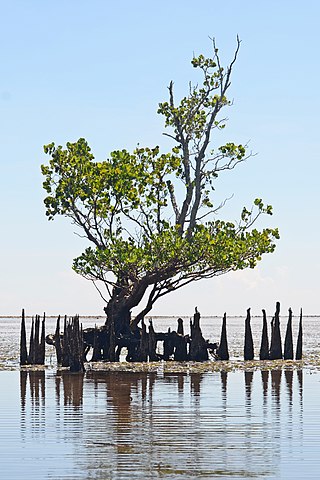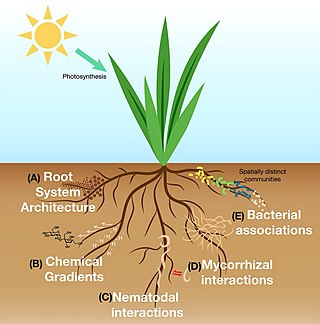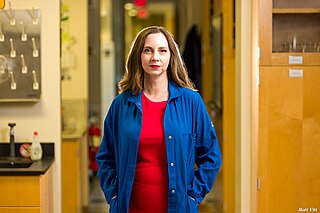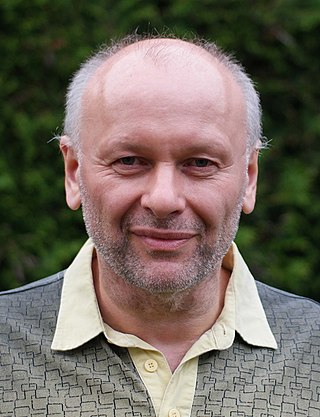Related Research Articles

A mangrove is a shrub or tree that grows mainly in coastal saline or brackish water. Mangroves grow in an equatorial climate, typically along coastlines and tidal rivers. They have special adaptations to take in extra oxygen and to remove salt, which allow them to tolerate conditions that would kill most plants. The term is also used for tropical coastal vegetation consisting of such species. Mangroves are taxonomically diverse, as a result of convergent evolution in several plant families. They occur worldwide in the tropics and subtropics and even some temperate coastal areas, mainly between latitudes 30° N and 30° S, with the greatest mangrove area within 5° of the equator. Mangrove plant families first appeared during the Late Cretaceous to Paleocene epochs, and became widely distributed in part due to the movement of tectonic plates. The oldest known fossils of mangrove palm date to 75 million years ago.

The rhizosphere is the narrow region of soil or substrate that is directly influenced by root secretions and associated soil microorganisms known as the root microbiome. Soil pores in the rhizosphere can contain many bacteria and other microorganisms that feed on sloughed-off plant cells, termed rhizodeposition, and the proteins and sugars released by roots, termed root exudates. This symbiosis leads to more complex interactions, influencing plant growth and competition for resources. Much of the nutrient cycling and disease suppression by antibiotics required by plants occurs immediately adjacent to roots due to root exudates and metabolic products of symbiotic and pathogenic communities of microorganisms. The rhizosphere also provides space to produce allelochemicals to control neighbours and relatives.

Soil respiration refers to the production of carbon dioxide when soil organisms respire. This includes respiration of plant roots, the rhizosphere, microbes and fauna.
William H. Schlesinger is a biogeochemist and the retired president of the Cary Institute of Ecosystem Studies, an independent not-for-profit environmental research organization in Millbrook, New York. He assumed that position after 27 years on the faculty of Duke University, where he served as the Dean of the Nicholas School of the Environment and Earth Sciences and James B. Duke Professor of Biogeochemistry.
Joy K. Ward is an American evolutionary biologist studying the impact of the environment on plants and ecosystems. She began a new role as the dean of the College of Arts & Sciences at Case Western Reserve University on July 1, 2020 - leaving behind her professorship at the University of Kansas. Her research on plant life has gained her notoriety in many scientific research fields. Aside from her work in the lab, she is also a strong advocate for advancing underrepresented communities' scientific learning and careers. As part of her deanship at the University of Kansas, Ward was an important factor in increasing the number of underrepresented individuals who held faculty positions in STEM subjects. Notably, as a result of her research efforts, she was awarded the Presidential Early Career Award for Scientists and Engineers by U.S. President Barack Obama.
Soil microbiology is the study of microorganisms in soil, their functions, and how they affect soil properties. It is believed that between two and four billion years ago, the first ancient bacteria and microorganisms came about on Earth's oceans. These bacteria could fix nitrogen, in time multiplied, and as a result released oxygen into the atmosphere. This led to more advanced microorganisms, which are important because they affect soil structure and fertility. Soil microorganisms can be classified as bacteria, actinomycetes, fungi, algae and protozoa. Each of these groups has characteristics that define them and their functions in soil.

Soil carbon storage is an important function of terrestrial ecosystems. Soil contains more carbon than plants and the atmosphere combined. Understanding what maintains the soil carbon pool is important to understand the current distribution of carbon on Earth, and how it will respond to environmental change. While much research has been done on how plants, free-living microbial decomposers, and soil minerals affect this pool of carbon, it is recently coming to light that mycorrhizal fungi—symbiotic fungi that associate with roots of almost all living plants—may play an important role in maintaining this pool as well. Measurements of plant carbon allocation to mycorrhizal fungi have been estimated to be 5 to 20% of total plant carbon uptake, and in some ecosystems the biomass of mycorrhizal fungi can be comparable to the biomass of fine roots. Recent research has shown that mycorrhizal fungi hold 50 to 70 percent of the total carbon stored in leaf litter and soil on forested islands in Sweden. Turnover of mycorrhizal biomass into the soil carbon pool is thought to be rapid and has been shown in some ecosystems to be the dominant pathway by which living carbon enters the soil carbon pool.

The root microbiome is the dynamic community of microorganisms associated with plant roots. Because they are rich in a variety of carbon compounds, plant roots provide unique environments for a diverse assemblage of soil microorganisms, including bacteria, fungi, and archaea. The microbial communities inside the root and in the rhizosphere are distinct from each other, and from the microbial communities of bulk soil, although there is some overlap in species composition.
Ellen Kandeler is a German biologist and agricultural scientist specialising in soil biology at University of Hohenheim. She also heads the Soil Biology area in the EU Biofector project.

Kathleen Kay Treseder is an American ecologist who specializes in the interplay between global climate change and fungal ecology. She also serves as a member of the Irvine City Council after being elected to the position in 2022. She is currently a professor in the Department of Ecology and Evolutionary Biology at the University of California, Irvine. She is a Fellow of the American Association for the Advancement of Science, the American Academy of Microbiology, and the Ecological Society of America.
Nancy Huntly is an American ecologist based at Utah State University, where she is a Professor in the Department of Biology and director of the USU Ecology Center. Her research has been on biodiversity, herbivory, and long-term human ecology. She started her position at USU in 2011, after serving as a Program Officer in the Division of Environmental Biology at the National Science Foundation. Prior to that she was a faculty member in the Department of Biological Sciences at Idaho State University (Pocatello).
Tamara Jane Zelikova is a climate change scientist, advocate and communicator interested in the impacts of environmental change on natural and managed ecosystems. Her interests are broad and include tropical biogeochemistry, as well as the effects of climate change on organisms big and small. She combines a strong emphasis on research with an interest in science communication and outreach, thinking about ways to expand the role of science in tackling global issues.
M. Francesca Cotrufo is a soil ecologist who focuses her work on litter decomposition and the dynamics of soil organic matter. She is currently a Professor and Associate Head in the Department of Soil and Crop Sciences, as well the Senior Scientist at the Natural Resource Ecology Lab, at Colorado State University.
Christine Goodale is an ecosystem ecologist and an Associate Professor in the Department of Ecology and Evolutionary Biology at Cornell University. Goodale conducts research that studies the cycling of water, carbon, nitrogen and other nutrients through forest ecosystems.
Ingrid C. "Indy" Burke is the Carl W. Knobloch, Jr. Dean at the Yale School of Forestry & Environmental Studies. She is the first female dean in the school's 116 year history. Her area of research is ecosystem ecology with a primary focus on carbon cycling and nitrogen cycling in semi-arid rangeland ecosystems. She teaches on subjects relating to ecosystem ecology, and biogeochemistry.

The plant microbiome, also known as the phytomicrobiome, plays roles in plant health and productivity and has received significant attention in recent years. The microbiome has been defined as "a characteristic microbial community occupying a reasonably well-defined habitat which has distinct physio-chemical properties. The term thus not only refers to the microorganisms involved but also encompasses their theatre of activity".
Aimée Classen is an American ecologist who studies the impact of global changes on a diverse array of terrestrial ecosystems. Her work is notable for its span across ecological scales and concepts, and the diversity of terrestrial ecosystems that it encompasses, including forests, meadows, bogs, and tropics in temperate and boreal climates.

Yakov Kuzyakov is a soil scientist professor.
Joan Gardner Ehrenfeld was an American environmental scientist who was a professor at Rutgers University. Her research considered invasive species and ecology. She was elected Fellow of the American Association for the Advancement of Science in 2000.
Leslie A. Weston FAA, is a plant biologist, who was awarded a Fellow of the Australian Academy of Science in 2023, for her work on weed suppressing ground covers and pest management. She is a professor at Charles Sturt University, at Wagga Wagga, and researches botany, agronomy, weed control and horticulture.
References
- 1 2 3 "MBL's Zoe Cardon is Elected Fellow of the Ecological Society of America". The Well. 2018-03-01. Retrieved 2019-09-13.
- 1 2 "Associated Faculty and Scientists | The Microbiome Center | The University of Chicago". microbiome.uchicago.edu. Retrieved 2019-09-13.
- 1 2 "Cardon, Zoe". vivo.brown.edu. Retrieved 2019-09-13.
- ↑ "USU'S Scholar of the Year Can Do a Variety of Things – Very Well". Deseret News. 1988-06-01. Retrieved 2019-09-13.
- ↑ University, Utah State. "Past Award Winners | Science". www.usu.edu. Retrieved 2019-09-13.
- ↑ "Enthusiasm, accessibility earn Cardon first Outstanding Advisor award - April 19, 1999". www.advance.uconn.edu. Retrieved 2019-09-13.
- ↑ "Hrdy Fellowship". oeb.harvard.edu. Retrieved 2019-09-13.
- ↑ "Microbiome Innovation: Roadmap to the Future – Report from the White House". The American Microbiome Institute. 28 September 2015. Retrieved 2019-09-15.
- ↑ "Zoe G. Cardon". The Ecosystems Center. 2012-05-18. Retrieved 2019-09-13.
- ↑ Cardon, Z. G.; Hungate, B. A.; Cambardella, C. A.; Chapin, F. S.; Field, C. B.; Holland, E. A.; Mooney, H. A. (2001-03-01). "Contrasting effects of elevated CO2 on old and new soil carbon pools". Soil Biology and Biochemistry. 33 (3): 365–373. doi:10.1016/S0038-0717(00)00151-6. ISSN 0038-0717.
- ↑ Cardon, Zoe G. (1996). "Influence of rhizodeposition under elevated CO₂ on plant nutrition and soil organic matter". Plant and Soil. 187 (2): 277–288. doi:10.1007/BF00017093. ISSN 0032-079X. JSTOR 42947911. S2CID 20999254.
- ↑ Cardon, Zoe G.; Stark, John M.; Herron, Patrick M.; Rasmussen, Jed A. (2013-11-19). "Sagebrush carrying out hydraulic lift enhances surface soil nitrogen cycling and nitrogen uptake into inflorescences". Proceedings of the National Academy of Sciences. 110 (47): 18988–18993. Bibcode:2013PNAS..11018988C. doi: 10.1073/pnas.1311314110 . ISSN 0027-8424. PMC 3839719 . PMID 24191007.
- ↑ Cardon, Zoe G.; Gray, Dennis W.; Lewis, Louise A. (2008-02-01). "The Green Algal Underground: Evolutionary Secrets of Desert Cells". BioScience. 58 (2): 114–122. doi: 10.1641/B580206 . hdl: 1912/2101 . ISSN 0006-3568.
- ↑ "ESA Fellows – The Ecological Society of America" . Retrieved 2022-09-12.
- ↑ "MBL's Zoe Cardon is Elected Fellow of the American Association for the Advancement of Science". Marine Biological Laboratory. Retrieved 2022-09-12.